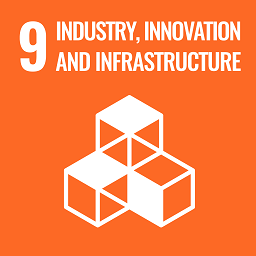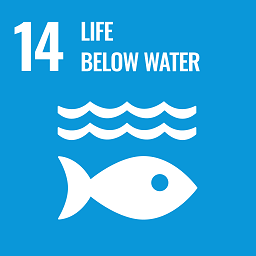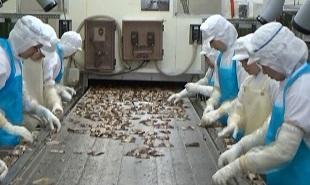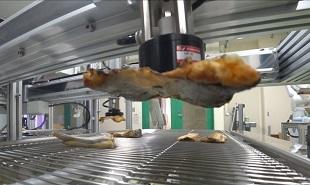Outcome Example of Bio-oriented Technology Research Advancement Institution
Issued on September 1, 2020




Iwate University developed work robots
In marine product processing plants, where fishes, such as sardine and saury, are processed into canned products, there is a constant worker shortage, and the workers' aging progresses. A research team led by Dr. Tasuku Miyoshi, professor at Faculty of Science and Engineering, Graduate School of Science and Engineering, Iwate University, developed a "robot for quantitative filling work" capable of recognizing the sizes of sliced saury and filling a given amount of slices in cans using artificial intelligence (AI). A demonstration experiment will begin soon. Spreading of the robots' utilization over the marine product processing industry is expected to contribute to a big improvement in productivity. Consequently, the revitalization of the marine product processing industry depressed after the Great East Japan Earthquake can be expected.
Picking up slices directly and filling in cans with no contact
The process of producing canned saury kabayaki involves the main steps of cutting saury into slices, roasting the slices, and filling a given volume of the slices in cans with a good appearance. In the step of cutting fish into slices and roasting the slices, dedicated machines have been used. However, the last step of performing "quantitative filling work," occupying about 30% of the entire process, is difficult to mechanize. It thus still depends heavily on manpower (human-wave-tactics) (Image 1).
Experience and skills achieved over the years are required for workers in a standing position to work efficiently on selecting out the slices appropriately and skillfully to pack the same volume of content and filling them in cans. Thus, there is a shortage of new manpower because of hard work, and the aging of workers is becoming an issue. Therefore, how to mechanize this quantitative filling work has been a big issue to be solved.
 |
 |
| Image 1: Filling work by manpower | Image 2: Robot hand picking up a slice |
(Supplied by Iwate University)
To solve the issue, Dr. Miyoshi et al. focused on a robot for quantitative filling work. They have had an AI robot learn the skilled workers' know-how since 2015 and have been developing a full automation of the canned product manufacturing process.
In the step of filling kabayaki saury slices in cans, one of the tail parts and trunk parts of roasted saury slices on a belt conveyor are picked up to fill in cans. When filling the slices in a can, the workers require to put the skin side of the tail part upward at the can's bottom and lay a trunk part with the skin side down onto the tail part. The net content filled in a can is specified as about 80 g. They planned out an idea to let a robot perform simple but complicated filling work.
To achieve this idea, Dr. Miyoshi et al. have been engaged in developing a robot capable of quickly recognizing the sizes, weights, and positions of the saury slices on a belt conveyor and appropriately picking them up. This robot is capable of skillfully reversing the tail of the saury to put the skin side upward. The robot is characterized in that it has a "non-contact hand" (Photo 2) capable of rapidly picking up a saury slice by means of air suction power with no contact and putting it into the can.
Annual cost may be cut down by tens of millions of yen
The time required for the robot hand to rapidly pick up the roasted slice, smoothly transport it, and swiftly filling it in a can is only 8 s. The robot's processing speed is at the same level as that of human workers. At present, it takes about 8 h for 12 workers to manufacture 100,000 canned products per day. When the robot system is introduced, the robot will perform this work more smoothly.
The cost required for introducing the robot with labor equivalent to labor of 12 workers is estimated to be about 50 million yen; however, it is expected that labor costs of tens of millions of yen may be saved per year.
A demonstration experiment will begin within a year!
This robot system may be applicable to the manufacturing of canned products of other fishes, including sardine and mackerel. It is applicable to making packed lunches at convenient stores and filling ingredients in retort pouches.
A demonstration experiment will be performed to verify the fruitful results achieved by the robot system within a year in cooperation with Tsuda Shouten, a manufacturer and seller of canned products and frozen food products (Kamaishi, Iwate). Dr. Miyoshi says, "Introduction of a robot system that can improve the productivity may lead to the supply of canned products of nutrient-rich and good-catch fishes, including sardine and mackerel at lower costs, and contribute to the improvement of people's health. Moreover, an improvement of the productivity in plants enables workers to shift to higher value-added workplaces, leading to the revitalization of local industries and food manufacturers" in hopes of the future spreading effect.
※The scenes in which the AI robot picks up saury slices and fills them in cans skillfully with no touch can be watched on YouTube. Links:
[Iwate Miyoshi Lab]
Project name
The special scheme project on advanced research and development for next-generation technology
Project period
FY 2016 to 2018
Title
Development of the robot system for processing good-catch fishes
Leading research institute
Iwate University
